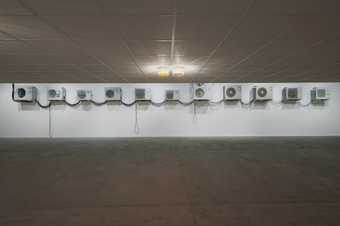Ima-Abasi Okon seeks an alternative form of communication through a language of objects and materials
Ima-Abasi Okon has inserted a modular ceiling underneath the original. Similar ceilings are often found in offices and waiting rooms.
The artist has smeared the ceiling tiles with an invisible mixture of morphine, insulin, ultrasound gel and gold. Four hand-crafted glass lights, filled with palm oil and Courvoisier VS cognac, spread a golden glow through the space. Eleven industrial air conditioners are placed along the walls of the gallery. Directed towards the space above the inserted ceiling, they follow a composed score from a slowed down audio track. The units switch to different rhythms and speeds, filling the gallery with sound.
Okon has also designed her own artwork labels. The works and their titles encourage us to stop and slow down, to look at language differently. Industrial and hand-crafted materials are used to explore our relationship to labour, value and taste.
The artist draws attention to objects and materials that are often exhausted by capitalist systems, imbuing these everyday items with a spiritual charge. Disturbing the architecture and formal atmosphere of Tate Britain, the installation stages the unseen, offering space for what has yet to be.
Responses
Explore Ima-Abasi Okon’s display through responses to its materials. A programme developed by Taylor Le Melle, writer and frequent collaborator with Okon.
Audio recordings: Oil and Spirit
In these audio recordings artists Otobong Nkanga and herbalists Katja Swift and Ryn Midura reflect on the distribution and medicinal properties of palm oil and cognac.
Audio Description: Works by Ima-Abasi Okon
This audio description of Okon's works has been written by Elaine Lillian Joseph.
Ima-Abasi Okon: A Reader
Artists Lydia Gifford and Anthea Hamilton, DJ Jody Simms and writer Fernando Domínguez Rubio reflect on formal techniques that are important to Okon’s work: stretching, opacity and shine. With an introduction by Taylor Le Melle, and a foreword by Anthea Hamilton.
This publication is available from Tate’s Library. To access this, you can book an appointment to visit the Reading Rooms or download a scanned copy from Tate's Library Catalogue.

